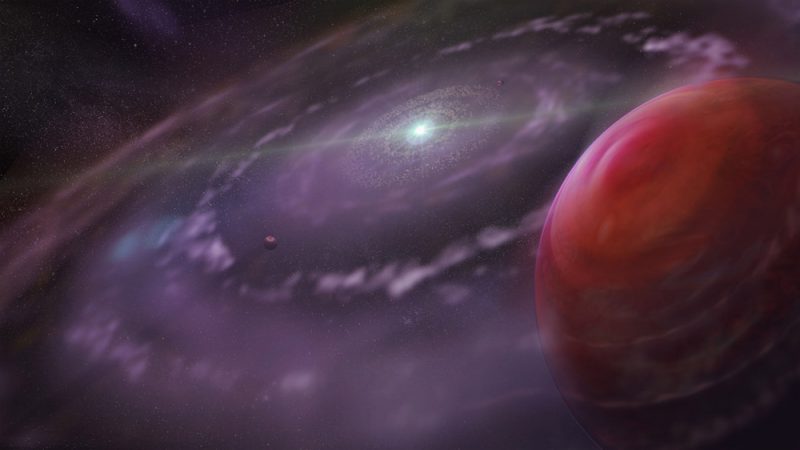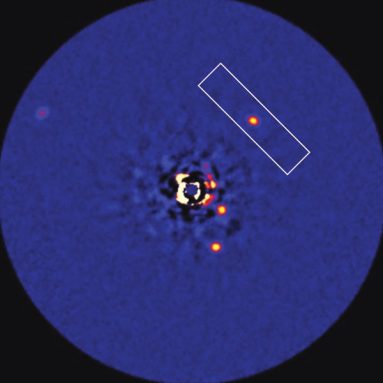Out-of-this-world atmospheres
Light from a distant, giant world offers clues to the gases in its atmosphere

The study of planets outside the solar system just took a big jump forward. Scientists have identified some of the gases that make up the atmospheres of four exoplanets circling the same star.
“This is the start of a great new era in exoplanet studies,” Sara Seager told Science News. Seager, who did not take part in the new studies, is a planet hunter at the Massachusetts Institute of Technology in Cambridge.
Astronomers have identified hundreds of exoplanets in the past few decades. But details about most have remained out of reach.
Planet hunters usually study an exoplanet by studying light from its host star. A brief dimming of starlight suggests a planet has crossed in front of its star. And a wobble in starlight indicates a planet’s gravity tugging on the star. Such information points to the existence of an exoplanet and gives a rough gauge of its size. But not much else. In two new studies, scientists measured light emitted directly by the exoplanets. From that, they figured out that the planets have atmospheres and what’s in them.
An atmosphere blankets a planet with gases. Earth’s atmosphere contains a rich mix of oxygen, nitrogen and other gases. The atmospheres of gas giants such as Neptune and Saturn contain large amounts of helium and hydrogen.
Astronomers identified and measured the gases surrounding the exoplanets by looking at how they affect light that leaves them.
Light travels as a collection of waves of energy. Each color has its own wavelength, which can be measured as the distance from the top of one wave to the top of the next wave. Some wavelengths are invisible.
Light leaving a planet can be changed as it passes through that planet’s atmosphere. One type of gas in the atmosphere may absorb light only at a particular wavelength. Or a gas may add a different wavelength of light. When a planet’s light reaches Earth, scientists can detect which wavelengths have been altered. From that, they can calculate what gases — here, an atmosphere — the light must have passed through to cause such changes.
All four of the exoplanets are scorching hot. That’s why scientists could measure them. Hot objects — whether hot potatoes or hot planets — send out waves of invisible light called infrared radiation. Because these planets are so far from their star, their light can be distinguished separately from their sun’s.
As the infrared light passed through each planet’s atmosphere, it underwent telltale changes that scientists have now begun to identify.
Jonathan Fortney at the University of California, Santa Cruz, told Science News that he hadn’t expected scientists to have this type of information about exoplanets for a decade. Also a planet hunter, Fortney did not work on the new analyses.
Quinn Konopacky of the University of Toronto, in Canada, and her team studied the infrared light coming from HR 8799c. Their analysis showed that the planet’s atmosphere contains water and a gas called carbon monoxide. This planet gets its name from its star — HR 8799. This world is five to 10 times as massive as Jupiter. It’s also about 130 light-years away. (That means its light took 130 years to reach Earth.)

A second group of astronomers studied infrared light from that planet and three more orbiting the same star. Ben Oppenheimer of the American Museum of Natural History in New York City led this study, which will be published soon. He told Science News that each planet in this star system has a different mix of gases in its atmosphere.
And, he adds, “they’re different from anything in our own solar system.”
Scientists can learn much about a planet by studying its atmosphere. Such information may even help astronomers make an educated guess about how that world formed. By learning more about the formation of the possibly hundreds of billions of exoplanets in our galaxy, scientists may even learn more about Earth’s early life.
Power Words
exoplanet A planet that orbits a star outside the solar system.
atmosphere The envelope of gases surrounding Earth or another planet.
infrared radiation Invisible radiation whose waves are longer than red light but shorter than microwaves.
gravity The force that attracts any body with mass, or bulk, toward any other body with mass. The more mass there is, the more gravity there is.
light-year The distance light travels in a year in a vacuum, nearly 6 trillion miles.







